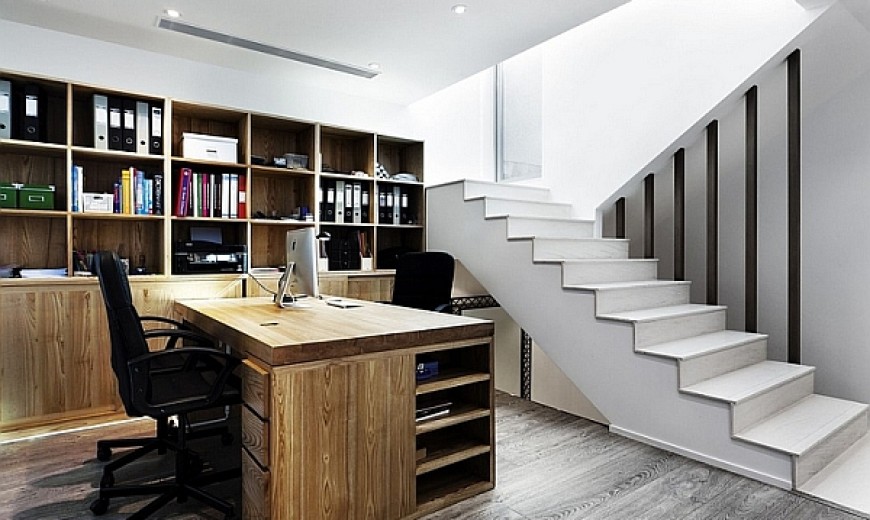In today’s work-from-home era, having a quiet, organized, and inspiring home office is more important than ever. If your main living space is too noisy or cramped, consider turning your underused basement into a highly functional workspace. With professional basement remodeling, you can create a private, customized home office that boosts productivity and adds long-term value to your home.
Whether you’re a full-time remote worker, freelancer, or hybrid employee, this guide will show you how to transform your basement into a dream workspace that blends comfort, functionality, and modern design.
Why Turn Your Basement into a Home Office?
Most basements offer ample square footage, separation from distractions, and design flexibility. Instead of working from the kitchen table or a makeshift corner of your bedroom, remodeling your basement into an office provides several advantages:

Key Benefits:
- Quiet and private: Located away from daily household noise.
- Increased productivity: Dedicated workspace helps maintain focus and work-life boundaries.
- Fully customizable: Tailor every detail — lighting, layout, tech setup, and aesthetics.
- Adds home value: Increases usable square footage and appeals to future buyers.
- Multi-purpose potential: Use as a guest room, study, or creative studio when not working.
Read More: Dedicated Basement Theater: Your Ultimate Guide to Building the Perfect Home Cinema
Key Elements of a Functional Basement Home Office
Creating a basement office isn’t just about putting a desk in an empty room. It requires careful planning, especially in below-ground spaces that may need waterproofing, insulation, and ventilation improvements.
1. Moisture Control & Waterproofing
Before you begin, address moisture issues. A dry basement is critical for maintaining a healthy work environment and protecting your electronics.
- Install sump pumps or interior drainage systems if needed.
- Use mold-resistant drywall and moisture-sealed flooring.
- Apply waterproof paint or sealant on foundation walls.
Read More: New Basement Finish? Here’s Everything You Need to Know to Get Started
2. Lighting & Electrical Setup
Basements often lack natural light, so your lighting plan is essential.
- Install recessed LED lighting or track lights with adjustable brightness.
- Use color temperature bulbs (4000K–5000K) to mimic natural daylight.
- Add task lighting for desks and accent lighting for ambiance.
- Include ample electrical outlets, USB ports, and surge-protected circuits.
Read More: General Basement Home Theater Build: A Complete Guide for Homeowners
3. Soundproofing
To maintain focus and privacy, incorporate soundproofing features:
- Insulate ceilings with acoustic batts.
- Use solid-core doors to reduce noise transfer.
- Add area rugs, curtains, or acoustic panels to absorb sound.
Read More: New Homeowner Basement Renovation: A Complete Beginner’s Guide
4. Flooring Options
Choose flooring that’s both functional and comfortable:
- Luxury vinyl plank (LVP) – durable, waterproof, and stylish.
- Carpet tiles – provide warmth and sound insulation.
- Engineered hardwood – for a polished look with stability in below-grade conditions.
Read More: Transforming Your Basement into a Livable Space: A Complete Guide
5. Ventilation & Climate Control
A comfortable climate is critical for productivity:
- Extend your home’s HVAC system or install a mini-split unit.
- Add vent fans or dehumidifiers to manage air quality.
- Use double-insulated windows if natural light is included.
Read More: A Guide to Planning Your Basement Remodel
6. Storage & Organization
Keep your office clutter-free with smart storage solutions:
- Built-in shelving or cabinets
- Wall-mounted organizers or pegboards
- Under-desk storage drawers
Read More: Best Basement Remodeling Ideas for Additional Living Space
Design Ideas for a Stylish Basement Home Office
Make your space inspiring, not just functional. These design ideas combine style and productivity:

Executive-Style Office
- Wood paneling or dark matte walls
- Large desk with dual monitors
- Leather seating and rich textures
- Wall art, bookshelf, and globe bar for sophistication
Read More: Basement Renovations & Remodeling in the Chicago Area: A 2024 Homeowner’s Guide
Minimalist Work Haven
- White or light gray walls with natural wood accents
- Floating desk or corner setup
- Live plants and soft lighting
- Minimalist decor and hidden cable management
Read More: Basement Remodeling & Finishing in Chicago: A Complete Guide for 2024
Creative Studio
- Open layout for photography, art, or writing
- Large worktable and storage bins
- Sound system, mood lighting, and wall-mounted inspiration boards
Read More: DIY Basement Renovation: The Ultimate 2024 Guide to Transform Your Space
Dual-Purpose Learning Zone
- One side for your remote work
- The other side for kids’ virtual learning or homework
- Custom cabinetry and whiteboards
Read More: Basement Framing: Top Guide to Master DIY in 2024
Basement Remodeling Process for Home Offices
Here’s a step-by-step breakdown of what to expect when remodeling your basement into a home office:
1. Initial Consultation & Planning
- Assess your needs, style preferences, and basement condition.
- Develop layout and design concept with your contractor.
- Determine the budget and materials.
Read More: DIY Tips for Low-Impact Basement Remodeling: Upgrade Without Breaking the Bank
2. Waterproofing & Framing
- Inspect and resolve any leaks or foundation issues.
- Frame out walls, ceiling, and any custom built-ins.
Read More: 96 Best DIY Basement Ideas to Transform Your Space
3. Electrical & Plumbing Work
- Install lighting, outlets, data ports, and backup power.
- Add plumbing if incorporating a bathroom or coffee station.
Read More: How to Build Basement Storage Ceiling Shelves: Maximize Overhead Space
4. Drywall, Flooring & Painting
- Insulated drywall for warmth and sound control.
- Durable, attractive flooring based on style and comfort.
- Choose paint colors that promote calm and concentration.
Read More: DIY Basement Storage Shelves: A Complete Guide to Maximizing Space
5. Furnishing & Finishing Touches
- Select ergonomic furniture, storage, and tech gear.
- Add personal design elements — wall art, plants, rugs.
Read More: How to Install Shelves on a Concrete Basement Wall (DIY Guide)
Cost to Remodel a Basement into a Home Office
The cost of a basement office remodel depends on your layout, materials, and whether major upgrades (like waterproofing or HVAC) are needed.
| Feature | Estimated Cost Range |
|---|---|
| Basic Office Setup | $10,000 – $20,000 |
| Mid-Level Remodel | $20,000 – $35,000 |
| High-End Custom Office | $35,000 – $60,000+ |
Tips to Save:
- Use existing walls or plumbing layouts where possible.
- Opt for pre-finished furniture or modular storage.
- Use LED lighting for long-term energy savings.
Read More: How to Build Shelves for Your Basement: A Complete DIY Guide
Local Considerations: Why Location Matters
If you live in a city like Chicago, Denver, or Boston, hiring a local basement remodeling contractor who understands regional codes and climate issues is vital. Cold winters, humid summers, and older home construction require expertise in:
- Insulation and vapor barriers
- Mold prevention
- Local permitting and egress requirements
Read More: 100 Best Basement Storage Ideas to Maximize Space and Organization
Why Hire a Professional Basement Remodeling Contractor?
DIY projects can be tempting, but a full basement remodel is complex and often requires professional expertise.
What Professionals Bring:
- Code-compliant construction
- Moisture and structural assessments
- Permit handling and inspections
- High-quality craftsmanship
- Project management and design support
Pro Tip: Always check references, view portfolios, and ensure your contractor is licensed and insured.
Read More: DIY Basement Shelving: Maximize Storage with These Smart Ideas
Final Thoughts: Boost Your Work Life with a Basement Office Remodel
Your basement has the potential to be more than just a storage area — it can be the most productive, peaceful, and polished space in your home. With the right design, materials, and contractor, your basement can become a fully functional home office that inspires focus and efficiency.
Whether you’re working remotely full-time or need a weekend workspace, remodeling your basement is a strategic move that pays off in productivity and property value.
